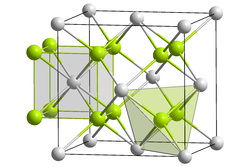Lithium oxide
| Crystal structure | |||||||||||||||||||
|---|---|---|---|---|---|---|---|---|---|---|---|---|---|---|---|---|---|---|---|

|
|||||||||||||||||||
| __ Li + __ O 2− | |||||||||||||||||||
| General | |||||||||||||||||||
| Surname | Lithium oxide | ||||||||||||||||||
| other names |
Dilithium oxide, lithia |
||||||||||||||||||
| Ratio formula | Li 2 O | ||||||||||||||||||
| Brief description |
white, odorless solid |
||||||||||||||||||
| External identifiers / databases | |||||||||||||||||||
|
|||||||||||||||||||
| properties | |||||||||||||||||||
| Molar mass | 29.88 g mol −1 | ||||||||||||||||||
| Physical state |
firmly |
||||||||||||||||||
| density |
2.01 g cm −3 |
||||||||||||||||||
| Melting point |
1427 ° C |
||||||||||||||||||
| solubility |
reacts with water |
||||||||||||||||||
| safety instructions | |||||||||||||||||||
|
|||||||||||||||||||
| As far as possible and customary, SI units are used. Unless otherwise noted, the data given apply to standard conditions . | |||||||||||||||||||
Lithium oxide is a chemical compound made up of lithium and oxygen . It is used for the production of lithium niobate and as an additive in ceramics and glasses.
Extraction and presentation
Lithium oxide can be produced by burning lithium or by thermal decomposition of lithium peroxide or lithium hydroxide .
properties
Lithium oxide is a white, odorless solid. It has an anti-fluorspar type crystal structure (a = 4.611 Å). The standard enthalpy of formation of lithium oxide is ΔH f 0 = −599.1 kJ / mol.
use
Lithium oxide is used as a starting material for the production of lithium niobate . It can also be used as an additive in the manufacture of ceramics and glasses. It can also be used in fusion reactors .
Individual evidence
- ↑ https://www.chemicalbook.com/ChemicalProductProperty_DE_CB7164125.htm
- ↑ a b c data sheet lithium oxide from AlfaAesar, accessed on December 15, 2010 ( PDF )(JavaScript required) .
- ↑ a b c data sheet lithium oxide from Sigma-Aldrich , accessed on April 8, 2011 ( PDF ).
- ^ George K. Schweitzer, Lester L. Pesterfield: The Aqueous Chemistry of the Elements . Oxford University Press, 2010, ISBN 978-0-19-974219-6 , pp. 100 ( limited preview in Google Book search).
- ^ AF Holleman , E. Wiberg , N. Wiberg : Textbook of Inorganic Chemistry . 101st edition. Walter de Gruyter, Berlin 1995, ISBN 3-11-012641-9 , p. 1152.
- ↑ a b Georg Brauer (Ed.), With the collaboration of Marianne Baudler u a .: Handbook of Preparative Inorganic Chemistry. 3rd, revised edition. Volume II, Ferdinand Enke, Stuttgart 1978, ISBN 3-432-87813-3 , p. 951.
- ^ AF Holleman , E. Wiberg , N. Wiberg : Textbook of Inorganic Chemistry . 101st edition. Walter de Gruyter, Berlin 1995, ISBN 3-11-012641-9 , p. 1176.
- ↑ Doctoral thesis Ulrich Grusemann .
- ↑ Lecture notes (PDF; 35 kB).
- ↑ Risely Technical Service Report: The use of lithium oxide as the breeder in fusion reactors . July 1989, p. 30.



